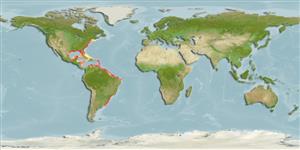>
Eupercaria/misc (Various families in series Eupercaria) >
Sciaenidae (Drums or croakers)
Etymology: Micropogonias: Greek, mikros = small + greek, pogon = beard (Ref. 45335).
More on author: Linnaeus.
Environment: milieu / climate zone / depth range / distribution range
ນິເວດວິທະຍາ
ສັດທະເລ; ນ້ຳກ່ອຍ ອາໄສຢູ່ໃກ້ໜ້າດິນໃຕ້ພື້ນທ້ອງນ້ຳ; ລະດັບຄວາມເລິກ ? - 100 m. Subtropical; 43°N - 37°S
Western Atlantic: Massachusetts, USA (excluding Florida) and northern Gulf of Mexico to northern Mexico. Possibly from southern Brazil to Argentina. Uncertain in southern Gulf of Mexico, Lesser Antilles and southern Caribbean (Ref. 26938).
Length at first maturity / ຂະໜາດ / ນ້ຳໜັກ / Age
Maturity: Lm ?, range 18 - ? cm
Max length : 55.0 cm TL ຕົວຜູ້/ບໍ່ມີເພດ; (Ref. 40637); common length : 30.0 cm TL ຕົວຜູ້/ບໍ່ມີເພດ; (Ref. 3702); ນ້ຳໜັກສູງສຸດທີ່ເຄຍຈັດພີມມາ: 2.6 kg (Ref. 40637); ອາຍຸສູງສຸດທີ່ເຄຍລາຍງານມາ: 5 ປີ (Ref. 12193)
Adults occur usually over mud and sandy mud bottoms in coastal waters and in estuaries where the nursery and feeding grounds are located. They feed mainly on worms, crustaceans and fishes. An excellent foodfish. Sold fresh and frozen; eaten fried, broiled, microwaved and baked (Ref. 9988).
Life cycle and mating behavior
ການຈະເລີນເຕັມໄວ | ການສືບພັນ | ການວາງໄຂ່ | ໄຂ່ | ຄວາມດົກຂອງໄຂ່ປາ | ຕົວອ່ອນ
Robins, C.R. and G.C. Ray, 1986. A field guide to Atlantic coast fishes of North America. Houghton Mifflin Company, Boston, U.S.A. 354 p. (Ref. 7251)
IUCN Red List Status (Ref. 130435)
Threat to humans
Harmless
Human uses
ການປະມົງ: ເປັນສີນຄ້າ; ການລ້ຽງສັດນ້ຳ: ການທົດລອງ; ຊະນິດປາທີ່ຖືກນຳໃຊ້ເຂົ້າໃນການຫາເພື່ອເປັນເກມກິລາ: ແມ່ນ
ຂໍ້ມູນຕື່ມອີກ
ຜູ້ຮ່ວມມືຮູບStamps, Coins Misc.ສຽງຫອຍມີພິດຊະນິດນຶ່ງທີ່ອາໄສໃນທະເລຄວາມໄວປະເພດການລອຍເນື້ອທີ່ເຫືອກOtolithsສະໝອງວິໄສທັດ
ເຄື່ອງມື
Special reports
Download XML
ແຫຼ່ງອີນເຕີເນັດ
Estimates based on models
Preferred temperature (Ref.
123201): 14.2 - 27.7, mean 24.1 °C (based on 540 cells).
Phylogenetic diversity index (Ref.
82804): PD
50 = 0.5156 [Uniqueness, from 0.5 = low to 2.0 = high].
Bayesian length-weight: a=0.00851 (0.00774 - 0.00936), b=3.09 (3.06 - 3.12), in cm total length, based on LWR estimates for this species (Ref.
93245).
ຊັ້ນເຂດຮ້ອນ (Ref.
69278): 4.0 ±0.50 se; based on food items.
ຄວາມຢືດຢຸ່ນ (Ref.
120179): ຂະໜາດກາງ, ປະຊາກອນຕຳ່ສຸດທີ່ໃຊ້ເວລາສອງເທົ່າ 1.4 - 4.4 ປີ (K=0.2-0.27; tm=1-2; tmax=5).
Fishing Vulnerability (Ref.
59153): Low to moderate vulnerability (34 of 100).
Climate Vulnerability (Ref.
125649): High to very high vulnerability (66 of 100).
Nutrients (Ref.
124155): Calcium = 74.3 [40.8, 145.2] mg/100g; Iron = 1.07 [0.56, 1.87] mg/100g; Protein = 20.1 [18.4, 21.7] %; Omega3 = 0.303 [0.149, 0.596] g/100g; Selenium = 26.2 [13.9, 50.6] μg/100g; VitaminA = 16.4 [5.7, 55.5] μg/100g; Zinc = 0.688 [0.492, 1.006] mg/100g (wet weight);
